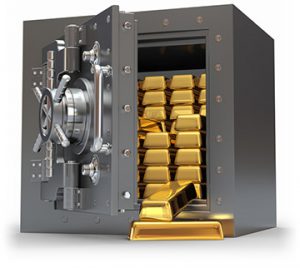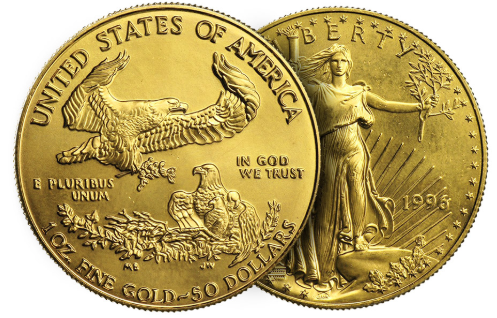Why Buy Gold?
 The main reason why people buy gold is as a safe haven during an economic crisis. Gold is the best hedge against a potential stock market crash. Why buy gold? Here are another dozen reasons:
The main reason why people buy gold is as a safe haven during an economic crisis. Gold is the best hedge against a potential stock market crash. Why buy gold? Here are another dozen reasons:
Gold Is Money
Why buy gold? Because gold’s historic role as money makes it superior to any currency. In fact, gold has been used as money longer than any other currency in history. Gold has been a value store for at least 3,000 years. One of the longest currencies in history, the British pound, is about 1,200 years old. Even the United States has used gold as money in its history. One of the key properties of money is that it serves as a long-term value store. Gold lives up to that promise better than any other Fiat currency. All the major government currencies have lost purchasing power in comparison to gold. All paper currencies lose value over time. The dollars you save on your bank or brokerage account will continue to lose purchasing power. The gold price may fluctuate, but its value is timeless.
Gold Can Protect Your Portfolio in Times of Crisis
One of the biggest benefits of gold is that it can protect your other investments. In times of economic, monetary or geopolitical crises it can even protect your standard of living. Depending on the nature of the crisis, gold can quickly turn from a defensive asset into a profit center. Gold is a natural safe haven, especially when a crisis strikes. When investors are worried about the stock market or by political events, fear can drive the markets. The greater the turmoil, the more gold is sought as a refuge and the higher the price. Much could be written about the various crises that are possible today. The point is that the risk in our economic, fiscal and monetary system is increased. There are so many risks that the price of gold is likely to reach new highs in response to any one of these events unfolding.
Diversification
 Perhaps diversification is the best reason why gold earns a place in your portfolio. Historically, gold has a negative correlation with stock market performance. What this means is that its value may fall as stocks rise, but gold can be expected to rise as stocks fall. Adding gold to an existing portfolio of other assets, such as stocks and bonds, reduces the volatility (risk) of the investment portfolio. As a result, it may increase the portfolio return. Gold is less affected by economic cycles and macroeconomic cycles than most other assets.
Perhaps diversification is the best reason why gold earns a place in your portfolio. Historically, gold has a negative correlation with stock market performance. What this means is that its value may fall as stocks rise, but gold can be expected to rise as stocks fall. Adding gold to an existing portfolio of other assets, such as stocks and bonds, reduces the volatility (risk) of the investment portfolio. As a result, it may increase the portfolio return. Gold is less affected by economic cycles and macroeconomic cycles than most other assets.
Gold Is a Tangible Asset
Why buy gold? Because when you buy physical gold, you can hold it in your hands. This is not possible with most other investments. Real gold is safe from the ravages of fire, water or time. Nor does gold is not required to be fed, fertilized or maintained. And due to its limited supply, it has an inherent value that many other assets do not have.
There is another strength that sets it apart in this modern, digital age. Gold cannot be hacked or deleted. Brokerage accounts, bank accounts, and payment services such as credit cards can be hacked, defrauded and stolen. Gold bullion, however is beyond the reach of identity thieves are inaccessible to computer hackers. Even if the ones and zeros used to create your account are deleted, the gold itself is safe. In today’s world, it just makes sense to have some of your assets out of digital form. If the Internet is not available or your online world breaks down, the gold coins you own are not affected. In this scenario, they could even be a lifesaver.
Long- Term Inflation Hedge
Physical gold has the ability to maintain its purchasing power over time. This is sometimes referred to as the “golden constant”. It reflects the fact that the purchasing power of gold is constant over long periods of time. The gold price reflects and adapts to changes in inflation and future inflation expectations. During inflationary cycles or when inflationary periods are anticipated, the price of gold rises. This intrinsic property is why physical gold acts as a long-term hedge against inflation.
Gold Can Be Private and Confidential
Gold can be stored anonymously. Whether in your home, or in a private vault in a jurisdiction where there are no reporting requirements such as Singapore. No one needs to know you have any gold at all or how much. Since gold has a high value-to-weight ratio, storage of gold does not take up much space. How many assets can make that claim in today’s world? Even bitcoin and crypto-currencies are ultimately traceable to counter money laundering regulations. If you want privacy, physical gold is one of the few assets that can provide it. Nobody needs to know that you own it. Virtually every other investment you make does not have that advantage. If you really want a private or confidential form of wealth, gold is one of the few assets that can provide this.
Gold is a Safe Haven Asset
Physical gold is a safe haven in times of conflict, war and geopolitical turbulence. Financial uncertainty increases during threats of wars, conflicts and economic turbulence. This uncertainty increases counterparty risk for most financial assets. Counterparty risk is the possibility that one of those involved in a transaction might default on their contractual obligation. Counterparty risk exists in credit, investment, and trading transactions. However, physical gold does not have a counterparty risk if you buy and hold it yourself. Gold is highly sought after during periods of uncertainty to protect and maintain wealth. It can therefore be considered as a form of financial protection against catastrophes.
Gold Is Liquid and Portable
Why buy gold? Because gold is easy to sell and can be carried anywhere in your pocket. Gold is very liquid. Virtually every gold trader in the world recognizes a gold eagle coin and would buy it from you. You can sell it to your local coin dealer, pawn shop, private party or online retailer. It can always be sold for cash or exchanged for goods. The process is often faster than selling a stock through your brokerage account. It usually takes 3 business days for the money to be transferred to your bank account or a check sent by mail.
Other collectibles, like works of art, could take even longer to sell, have a smaller customer base and probably require a large commission. But with gold, you can immediately get cash or goods in hand with very little hassle and complete privacy. This liquidity means that you can literally take gold with you anywhere in the world. Gold is easily convertible into cash and can be taken anywhere. Gold combines high value with high portability. In times of conflict and war, gold bars and gold coins are ideal for transporting wealth and savings anonymously across borders and within conflict zones.
Why Buy Gold? Because Gold Requires No Specialized Knowledge…
Can you recognize a real diamond? Can you look at two paintings and distinguish an authentic Rembrandt from a fake? Do you know which comic books, baseball cards and antique pieces of furniture are more valuable than others? Gold coins do not require anything like that. No special skills, training or equipment are required to buy or recognize bullion. You can buy rare gold coins, but this is a collector’s world that most investors should avoid. You do not need to speculate with a numismatic coin. Invest in gold bars and coins to protect yourself from crises or a loss of purchasing power. No rare coins are needed. Buying gold bars and bullion coins is relatively easy and purchasing physical gold does not require special skills or expertise.
Central Banks hold Gold
The world’s central banks are downplaying the importance of gold because it is in competition with their fiat currencies. However, most central banks continue to hold significant amounts of physical gold bullion in their vaults. They hold this gold as a currency reserve on their balance sheets and rate it at current market prices. Like private gold investors, central banks hold physical gold because it is highly liquid, with no counterparty risk, and because gold is a safe haven. This acts as financial insurance in times of crisis.
Central banks also hold gold in the event their unbacked fiat currencies should falter. If a new monetary system were ever required, gold would be the first choice to give that currency value. Gold could one day reappear at the center of a new monetary system. The central banks do not wish to be caught without any gold to back a new currency. Why buy gold? Because central banks still do…
Why Buy Gold? The Bottom Line…
Gold should be an important part of a diversified investment portfolio because its price increases in response to events that cause the value of paper investments, such as stocks and bonds, to decline. Although the price of gold can be volatile in the short term, it has always maintained its value over the long term. Through the years, it has served as a hedge against inflation and the erosion of major currencies, and thus is an investment well worth considering. If you’re worried about global and regional economic conditions, a healthy position in gold gives that buyer leverage. Gold, after all, always has value to someone. When times are tough, you can sell it for a good price to keep food on the table. Gold is in especially high demand during an economic calamity.
Should I buy Gold Now or Wait?
Are you having trouble deciding if you should buy gold now or wait? Although gold holds its value better than most investments over the long run, we all want the best price we can get right? It is only natural. Every good consumer will want to consider the timing of all significant investments. It’s a question that almost every investor asks – “can I get a better price later?” Well, let’s see if the historical price of gold can offer any suggestions…
When is the Best time to Buy Gold?
Gold tends to rise sharply in the first few months of the year. The price stalls in spring and summer and picks up again in the fall. This means that historically the best times to buy are early January, early April or early July. The gold price on average does not reach its annual low again. The year’s low is in January – but it’s the new year’s low, not the year before. Obviously, there were years when the price of gold fell from its prior year’s price. But there were also years when it rose. On average, since 1975, golds lowest price for the year tended to be in January of that year. Based on historical data, investors will receive their best price at the beginning of the year or the year before.
Best Month of the Year to Buy Gold
If you missed buying gold in January, when is the next best time to buy? Aside from January, Since 1975, gold prices have fallen the most in March and April. The historical daily charts may show that the April price may be slightly lower, but history shows that March is the month when gold falls the hardest and is therefore one of the best buying times. There are some conclusions that you can draw from historical records when buying gold…
- In early January, March or April and late June, gold is usually among the lowest prices of the year and is therefore a great time to buy.
- You want to be fully positioned before August.
- You will probably get a better price this year than next year. Whatever you want for your long-term holdings, buy it this year, not next year.
On the whole, though, it’s not so much about timing the exact bottom, but about how many ounces you secure before the next stock market drop. Remember, gold is inversely correlated with other assets, including equities. So you want to have a significant amount of gold before it comes to a stock market sell off. If you do not, the price of gold may well leave you behind.
Why Buy Gold Now
Remember, gold is inversely correlated with other assets, including equities. The main reason why people buy gold is as a safe haven during an economic crisis. Gold is the best hedge against a potential stock market crash. According to research, gold prices increased dramatically for 15-30 days after a stock market crash. So you want to have a significant amount of gold before it comes to a stock market sell off. If you do not, the price of gold may quickly leave you behind. You may then be forced to pay not only a higher price but also higher premiums and commissions. The point is that trying to time a market bottom is risky and might cause you to miss the chance to diversify and hedge now.
What is Dollar-Cost Averaging? Dollar Cost Averaging Explained
 Dollar Cost Averaging is a strategy by which an investor can periodically buy the same dollar amount of an investment. The purchases are made independent of the price of the asset. Make no mistake, dollar cost averaging is a strategy that will almost certainly lead to results that are as good or better than the goal of buying low and high selling. As many experts will tell you, nobody can time the market. Dollar cost averaging can be the next best thing.
Dollar Cost Averaging is a strategy by which an investor can periodically buy the same dollar amount of an investment. The purchases are made independent of the price of the asset. Make no mistake, dollar cost averaging is a strategy that will almost certainly lead to results that are as good or better than the goal of buying low and high selling. As many experts will tell you, nobody can time the market. Dollar cost averaging can be the next best thing.
Dollar Cost Averaging Explained
The strategy could not be easier. Invest in regular intervals, approximately monthly, the same amount of money in gold bullion. Ignore the price fluctuations of your investment. No matter if it goes up or down, you put in the same amount of money each month. The number of ounces purchased each month depends on the price of gold at the time of purchase. You can carry over odd amounts for the following month. To get the best price and lowest commissions, always buy full ounces with each purchase. Any leftover monies should be used the next month on top of your normal allocation.
Dollar Cost Averaging for New Investors
As the price of gold rises, your money buys fewer ounces per dollar invested. When the stock price falls, your money buys you more ounces. Over time, the average cost per ounce will probably be fairly cheap compared to the price you would have paid had you tried to time a lump purchase aiming for a bottom. In the long term, this is a very strategic way to invest. The strategy causes you to buy more gold when the price is low. Therefore, you will lower your average cost per ounce over time. Dollar cost averaging is particularly attractive to new investors who are just beginning. It’s a way to slowly but surely build wealth, even if you start with a small stake.
Set it and Forget it
Dollar cost averaging is a strategy that you can set and forget. There are no more decisions to make once you decide how much to invest each month and for how long. Once you set it in motion, you do not have to worry about timing the market or look for a bottom. All you have to do is regularly buy a certain dollar amount of gold, regardless of the price. The strategy forces you to buy less ounces if the price is high. However, you automatically buy more when the price is lower. This will save you from thinking and worrying about getting a good price. Below is a fictional example to explain how it works (these gold prices might seem silly).
Dollar Cost Averaging Example
Suppose you commit to buy $2,000 worth of gold every single month. Starting out the first month, gold sells for $1,000 so you’re able to buy 2 ounces. In the second month, gold trades for $1300, so you’re able to buy one ounce with $700 dollars to carry over. In the third month, gold sells for $900, so you’re able to buy 3 ounces with your $2,700, ($2,000 plus $700 carry over). At the end of three months, you own 6 ounces of gold at an average cost of $1,000 per ounce. By dollar cost averaging, you didn’t have to guess which way the price of gold was going or whether you were missing out on a better opportunity. The strategy smoothed out the price you paid.
Dollar Cost Averaging – Bottom Line…
In order to minimize the risk of market fluctuations, dollar cost averaging has distinct advantages. The strategy requires regular investment of the same amount (usually monthly), regardless of the price of an investment. If this strategy is followed, the average cost per share is reduced and the risk of buying at a high market level is reduced. It works remarkably well if the rules are followed with discipline. Unfortunately, most investors do not always follow the rules and often deviate from the strategy.
For many investors, price fluctuations can be intimidating. Dollar Cost Averaging is the easiest way to systematically invest – especially for new investors. Through this simple strategy, you automatically buy more when prices are low, and buy less when prices are high. It’s the easiest way to automate your investing and a proven method to buid wealth over time.
Are Gold Coins a Good Investment?
Absolutely, especially because gold bars and ingots can be faked…
One of the easiest – and safest ways to own gold is to buy 1 ounce gold coins for investment. Coins are issued and backed by the government mints that issue them, bars and ingots are not.
For more information, check out the article – Gold Coins for Investment – Why Buy Gold Coins?
Gold Stocks that Pay Dividends
Buying physical gold is a proven way to hold and store wealth. However, gold bullion does not generate income. The only way to realize any profit is to sell the gold. Those who like getting income from their investment portfolios tend to love dividend stocks. Owning Gold stocks is a way to enjoy increases in the price of gold with growth potential if the stock itself appreciates in value. Wouldn’t it be great to have the security of owning gold AND the growth potential of stock appreciation AND a steady stream of income in the form of regular dividend payouts? It’s possible, and you can do this by investing in gold stocks that pay dividends. For more information, check out the article – Gold Stocks that Pay Dividends – Best Gold Dividend Stocks for 2019



